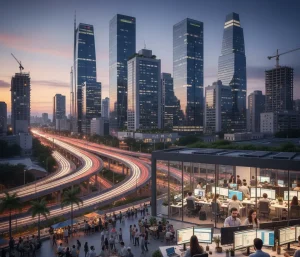Location Strategy 2025: Tier-II Cities & Emerging Markets
In the evolving global business environment, the selection of a location for a Global Capability Center (GCC) has shifted from being a matter of cost-efficiency to one of strategic significance. The current focus includes not only operational savings but also the potential to drive innovation, improve organizational resilience, access diverse talent pools, and create long-term value creation.
As we look ahead to Location Strategy 2025, an increasing number of organizations are directing their attention towards Tier-II cities and emerging markets. These regions are emerging as credible hubs for the creation and scaling of GCCs, reflecting a broader shift in corporate location strategies.
Why Location Strategy Matters for GCCs
The role of location in determining the success of GCCs is more strategically significant now than ever. The spread of hybrid work models, rapid digital transformation, and the growing need for operational agility are placing unrivalled demands on Tier‑I metropolitan areas.
These cities face rising costs of acquiring and retaining talent, leading to high attrition and intense hiring competition; soaring real estate and infrastructure expenses, especially for office space in prime tech corridors; and ever‑increasing competition for top professionals, particularly in highly specialized roles constraints that are limiting growth despite booming opportunity.
But truth to be told, Tier-II cities and select emerging markets are positioning themselves as attractive alternatives.
- Scalable ecosystems: These cities offer the right blend of expanding infrastructure, lower operating costs, and growing tech parks or innovation corridors that can support rapid business scale-up. Government-backed initiatives like smart city programs and industrial corridors are also accelerating infrastructure development.
- Access to skilled talent: With premier universities, regional engineering colleges, and a rising number of trained professionals choosing to stay in their hometowns post-pandemic, Tier-II cities now boast a deep and loyal talent pool across tech, analytics, and operations. Additionally, return migration trends are fueling a reverse brain drain, enriching these talent hubs.
- Supportive regulatory frameworks: State governments are offering attractive incentives such as capital subsidies, lower compliance burdens, and plug-and-play facilities to encourage companies to set up operations. In some cases, single-window clearances and special economic zones (SEZs) make it easier and faster for firms to begin operations.
Therefore, management teams recognize that an effective GCC location strategy is not only about operational efficiency; it is fundamentally about enabling innovation, scalability and differentiation in an increasingly competitive landscape.
The Rise of Tier-II Cities for Global Capability Centers
Over the past decade, Indian Tier-II cities have transitioned from peripheral locations to essential components of global enterprise strategy. Cities such as Coimbatore, Visakhapatnam, Bhubaneswar, Indore, Chandigarh, and Trivandrum now present significant opportunities, including access to skilled labour, reduced operational risk, and the ability to diversify beyond saturated metropolitan centers.
Such locations benefit from improvements in physical infrastructure, robust digital connectivity, and progressive state incentives.
Many organizations adopt a hub-and-spoke model, with Tier-I cities like Bengaluru or Hyderabad serving as major hubs, while Tier-II cities function as specialized spokes. A notable example of this is the Karnataka Digital Economy Mission’s (KDEM) “Beyond Bengaluru” initiative, which actively promotes the growth of digital innovation clusters in Tier-II cities like Mysuru, Mangaluru, and Hubballi-Dharwad. enabling them to become thriving technology and R&D hubs complementing the metro ecosystems.
Opportunities in Emerging Markets
While Tier-I cities have traditionally been the preferred sites for GCCs, there is a discernible shift towards Tier-II and Tier-III cities. These markets offer cost advantages and a growing ecosystem of academic partnerships, improved digital infrastructure, and government-led incentives to attract sustained investment.
A forward-thinking GCC location strategy for 2025 will likely involve a diversified domestic portfolio leveraging the scale and governance strengths of Tier-I cities, while capitalizing on the specialization and talent depth available in Tier-II locations. This diversification contributes to operational resilience, improved staff satisfaction, and regional economic development.
Talent Availability
One of the principal advantages of Tier-II cities is the availability of skilled, motivated talent at competitive costs. With as much as 60% of all of India’s technology graduates hailing from tier 2 and 3 cities, access to highly skilled talent is the biggest magnet attracting global enterprises to these cities. Local educational institutions are producing graduates proficient in engineering, analytics, finance, and emerging technologies. Organizations that establish an early presence in these cities can gain a first-mover advantage and develop a sustainable talent pipeline through partnerships with local universities.
Also, the pandemic-induced migration of professionals to their hometowns has led to a shift in preferences, with many individuals now prioritizing quality of life and work-life balance – these factors are hugely strengthening talent retention in Tier-II cities.
Cost and Infrastructure
Although cost considerations remain significant, they are not the sole factor influencing GCC location decisions. Tier-II cities generally offer 20–30% lower costs in real estate, utilities, and salaries compared to Tier-I metros.
Moreover, investments in infrastructure including modern office facilities, reliable digital connectivity, integrated transport, and airport access have made these cities increasingly viable.
Government initiatives, like favourable tax policies, streamlined approval processes, and skill development grants, further enhance these locations’ attractiveness for sustainable business expansion.
Making the Case: Location Strategy 2025
As companies rethink their global presence, moving into Tier-II cities and emerging markets isn’t just a complementary strategy anymore it’s now central to serious growth and long-term stability. Key decision makers need to assess their location strategies with a broader perspective that is factoring in 2025.
- Talent availability and skill levels
- Cost savings and overall sustainability
- Infrastructure quality and accessibility
- Geo-political risks and compliance issues
- Innovation networks and local partnerships
Many organizations are now embracing a hybrid location model, moving beyond Tier‑I metros. Emerging GCC hotspots in Tier‑II and other markets are rapidly evolving into centers for product development, AI, cybersecurity, finance, and customer experience. For instance, Eisai Pharma is launching a GCC in Visakhapatnam focused on digital healthcare and data science.
Global firms like Pernod Ricard, and Flex have established specialized centres in Nashik, and Coimbatore respectively. Infinx Healthcare recently inaugurated an AI-powered delivery centre in Madurai, creating 700 jobs in RCM and automation.
Meanwhile, cities such as Jaipur, Chandigarh, and Ahmedabad are drawing fintech and IT GCCs, underpinned by strong infrastructure, skilled local talent, and policy incentives.
Conclusion
In today’s hyper-competitive environment, a forward-looking GCC location strategy is no longer optional, it is a strategic imperative. By embracing a diversified, hybrid footprint that blends the scale, governance and global connectivity of Tier-I metros with the cost advantages, untapped talent pools and innovation ecosystems of Tier-II and emerging markets, organizations can build resilience against geopolitical and market-driven shocks, unlock new avenues for R&D and digital transformation, and secure long-term value creation.
Mature B2B leaders will therefore want to evaluate potential sites not just on cost metrics, but through the lens of talent sustainability, infrastructure robustness, regulatory agility and local partnership potential.
In 2025, the winners in location strategy will be those who treat their GCCs as agile innovation hubs, rooted in diverse geographies, united by a bold vision for growth and impact.




